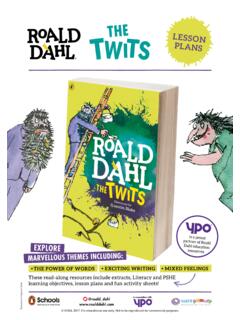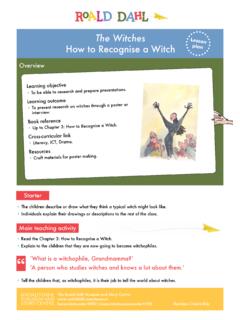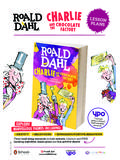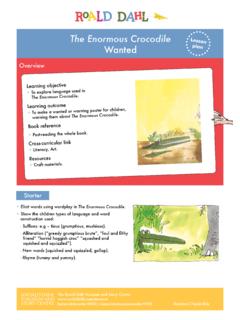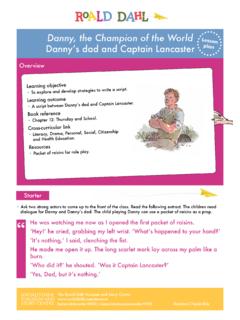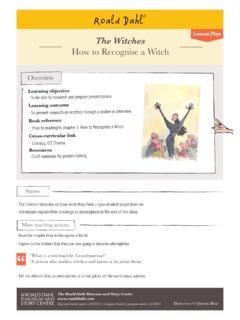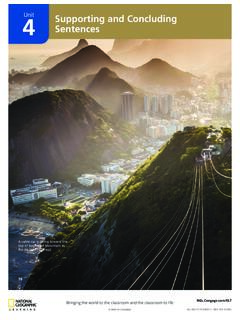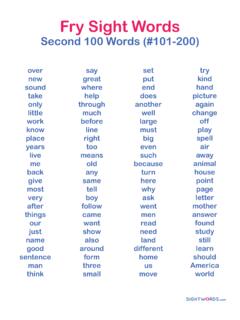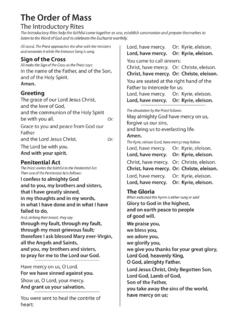Transcription of LESSON PLANS - Roald Dahl
1 EXCITING WRITINGT hese read-along resources include extracts, Literacy and PSHE learning objectives, LESSON PLANS and fun activity sheets!Illustrations Quentin Blake THE POWER OF WORDS MIXED FEELINGSLESSON PLANSMARVELLOUS THEMES INCLUDING:EXPLOREis a proud partner of Roald Dahl education @roald_dahlIn association with RDNL 2017. For educational use only. Not to be reproduced for commercial Quentin @roald_dahlIn association with2 CONTENTSLESSON PLAN 1: BOOK THEME: Good and badLITERACY OBJECTIVE: Using adjectives to describe key information to make predictions and OBJECTIVE: Evaluating characters and developing an understanding of how good and bad characters are USED: Mr Twit ( ), Dirty Beards ( ), Mrs Twit ( ) LESSON PLAN 2:BOOK THEME: Masters of inventionLITERACY OBJECTIVE: Identifying the structure of Roald Dahl s this structure to create a similar piece of writing. PSHE OBJECTIVE: Sharing ideas within a USED: The Frog ( ) The Glass Eye (p. 9) LESSON PLAN 3:BOOK THEME: Makers of mischief LITERACY OBJECTIVE: Using an authentic first person voice in OBJECTIVE: Managing praise and USED: Four Sticky Little Boys (p.)
2 41) LESSON PLAN 4:BOOK THEME: Champions of goodLITERACY OBJECTIVE: Identifying and creating rhyming OBJECTIVE: Working co-operatively as part of a pair or USED: The Roly-Poly Bird to the Rescue (p. 46) LESSON PLAN 5:BOOK THEME: Makers of mischiefLITERACY OBJECTIVE: Writing a set of instructions using the features of the text type. PSHE OBJECTIVE: Understanding that actions can have positive and negative consequences. Recognising how actions can affect the feelings of USED: The Great Upside Down Monkey Circus ( ) and Muggle-Wump Has an Idea (p. 57) LESSON PLAN 6:BOOK THEME: Champions of goodLITERACY OBJECTIVE:Identifying direct speech and its related features in a text. Using direct speech in OBJECTIVE: Developing awareness of how relationships work and of the skills to maintain USED: The Twits Are Turned Upside Down (p. 78)Illustrations Quentin @roald_dahlIn association with3 PREPARATION:Split your class into groups of four children. Ensure you have enough copies of RESOURCE 1: PHIZZ-WHIZZING ADJECTIVES for one per group.
3 Each group will also need a set of RESOURCE 3: DAHLICIOUS DISCUSSION CARDS cut up ready for child in your class will need a copy of RESOURCE 2: CHARACTER ACTIVITY: Read both extracts of text to the children and ask them to listen carefully to the character descriptions. Read them again and, as you read, invite children to draw a picture of what they think Mr and Mrs Twit look like without discussing the at the drawings. Are most of them the same? What is different? Discuss how children achieved their drawings (by listening for key information from the text, by listening for describing words, by inferring that the Twits are disgusting people).MAIN TASK: WONDROUS WORDS1. Split class into groups of four children. Using RESOURCE 1: PHIZZ-WHIZZING ADJECTIVES, each of the children should work individually to write down as many adjectives as they can in two minutes to describe Mr and Mrs Twit. They should do so in their allotted section of the resource. Continued ..BOOK THEMES: Good and badLESSON OBJECTIVES: Using adjectives to describe characters Identifying key information to make predictions and inferences Evaluating characters and developing an understanding of how good and bad characters are describedTHINGS YOU MAY NEED FOR THIS LESSON :HB pencils, colouring pencils and page 40 LESSON PLAN 1 Illustrations Quentin @roald_dahlIn association with42.
4 After the two minutes is up, they should share their ideas as a group and choose the best adjectives to write in the middle box. Invite groups to share these with the whole class to create a bank of adjectives. This activity could be extended to include similes as well as adjectives, using examples from the text ( page 3: spikes that stuck out straight like the bristles of a nailbrush, or page 7: good thoughts will shine out of your face like sunbeams .) 3. Use RESOURCE 2: CHARACTER PROFILE to write a character description of Mr or Mrs Twit using the adjectives and or similes from part 1. Encourage children to consider both the physical traits of the Twits and their personalities and Share character descriptions as a class or in groups and give THE ACTIVITY:Look at this short extract A person who has good thoughts cannot ever be ugly. You can have a wonky nose and a crooked mouth and a double chin and stick-out teeth, but if you have good thoughts they will shine out of your face like sunbeams and you will always look lovely.
5 Use RESOURCE 3: DAHLICIOUS DISCUSSION CARDS as a prompt to discuss this extract as a group. Can they think of other fictional characters for whom this is true? LESSON PLAN 1 PLENARY:Ask children the following questions, explaining that they will have to use their powers of inference and prediction!1. What have we learned about Mr and Mrs Twits personalities? What kind of people are they? Would you like to be friends with them? Why / why not?2. Why do you think Roald Dahl has spent so much time developing the characters at the beginning of the story?3. What kind of relationship do you think Mr and Mrs Twit will have in the story and how do you think it might develop?Illustrations Quentin @roald_dahlIn association with5 EXTRACT ONE from Mr Twit/Dirty Beards TwitMr Twit was one of these very hairy-faced men. The whole of his face except for his forehead, his eyes and his nose was covered with thick hair. The stuff even sprouted in revolting tufts out of his nostrils and ear-holes.
6 Mr Twit felt that this hairiness made him look terrifically wise and grand. But in truth he was neither of these things . Mr Twit was a twit. He was born a twit. And now at the age of sixty, he was a bigger twit than ever. The hair on Mr Twit s face didn t grow smooth and matted as it does on most hairy-faced men. It grew in spikes that stuck out straight like the bristles of a nailbrush. And how often did Mr Twit wash this bristly nailbrushy face of his? The answer is NEVER, not even on Sundays. He hadn t washed it for years. Dirty BeardsMr Twit didn t even bother to open his mouth wide when he ate. As a result (and because he never washed) there were always hundreds of bits of old breakfasts and lunches and suppers sticking to the hairs around his face. EXTRACT FROMI llustrations Quentin @roald_dahlIn association with6 EXTRACT TWO from Mrs Twit Twit was no better than her husband. She did not, of course, have a hairy face. It was a pity she didn t because that at any rate would have hidden some of her fearful ugliness.
7 In her right hand she carried a walking-stick. She used to tell people that this was because she had warts growing on the sole of her left foot and walking was painful. But the real reason she carried a stick was so that she could hit things with it, things like dogs and cats and small children. And then there was the glass eye. Mrs Twit had a glass eye that was always looking the other way. EXTRACT FROMI llustrations Quentin @roald_dahlIn association with7 This page is divided into four sections, one for each member of your group. You have two minutes to each note down all the adjectives you can think of to describe the Twits. Once you have done so, choose the best from each list and write them in the central box. PHIZZ-WHIZZINGADJECTIVESI llustrations Quentin @roald_dahlIn association with8 CHARACTERPROFILINGU sing your ideas from today s LESSON , write a profile of Mr Twit. Remember to use the adjectives and similes you have been discussing to make your character profile interesting and picture hereAppearance:Personality:Illustrations Quentin @roald_dahlIn association with9 DAHLICIOUSDISCUSSION CARDSDO YOU AGREE WITH Roald DAHL, A person who has good thoughts cannot ever be ugly ?
8 WHAT DO YOU think Roald DAHL MEANS BY good thoughts will shine out of your face like sunbeams ?DO YOU think THAT HOW A PERSON LOOKS IS VERY IMPORTANT? Why? Why not?WHY do you think Roald Dahl included this paragraph in the chapter about MRS TWIT?WHO WOULD YOU PREFER TO BE FRIENDS WITH, someone like this, or someone like Mrs Twit?WHAT DO YOU think Roald DAHL IS IMPLYING about Mrs Twit s personality? A person who has good thoughts cannot ever be ugly. You can have a wonky nose and a crooked mouth and a double chin and stick-out teeth, but if you have good thoughts they will shine out of your face like sunbeams and you will always look lovely. Illustrations Quentin @roald_dahlIn association with10 PREPARATION: Prepare enough copies of RESOURCE 1: WRITE LIKE Roald DAHL for one between every two children. You will also need to provide pairs with sets of highlighters. Gather a collection of objects such as: a piece of old fruit, a toy mouse, hair gel, a beard comb, a one copy per child of the RESOURCE 2: MAKING MISCHIEF and RESOURCE 3: SQUIFFING ACTIVITY: Mr and Mrs Twit play many nasty tricks on each other throughout the book.
9 Read extracts one and two with the children and discuss the way Dahl has structured these chapters. Does the reader know what is going to happen? If so, how? Explain to the children that they are going to write their own chapter and invent a new trick. Using RESOURCE 1: WRITE LIKE Roald DAHL ask the children to work in pairs to highlight the chapter using the given headings. Once they have done this, share the resources sheets as a class and discuss the following1. Why does Roald Dahl create the image of the Giant Skillywiggler ? 2. Can you identify where Roald Dahl (through Mr Twit) uses fear to enhance the trick? It ll bite off your toes! Why does he do this?3. How does Roald Dahl (through Mr Twit) use exaggeration to enhance the trick?Children requiring a challenge could work in pairs to deconstruct one of the extracts and share their findings. Is each one constructed in a similar way? They might also try to identify the format headings themselves, rather than having them provided on the.
10 BOOK THEMES: Masters of inventionLESSON OBJECTIVES: Identifying the structure of Roald Dahl s writing Using this structure to create a similar piece of writing Sharing ideas within a groupTHINGS YOU MAY NEED FOR THIS LESSON :Highlighters, colouring pens and creative writing resources. See page 40 LESSON PLAN 2 Illustrations Quentin @roald_dahlIn association with11 LESSON PLAN 2 Children requiring a challenge could work in pairs to deconstruct one of the extracts and share their findings. Is each one constructed in a similar way? They might also try to identify the format headings themselves, rather than having them provided on the ACTIVITY:1. Show children a range of objects or pictures of objects, for example: a piece of old fruit, a toy mouse, hair gel, a beard comb, a mirror. How might the Twits use these objects in a trick? Give pairs of children a few minutes to choose an object (either one of the objects provided or one of their own choosing) and decide how the Twits might use it.

